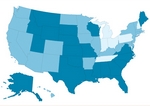business
Hospitals less secure about meeting meaningful use soon
■ They may have focused too much on computerized physician order entry systems without realizing the problems they would face in other areas.
By Pamela Lewis Dolan — Posted April 21, 2011
- WITH THIS STORY:
- » Related content
Hospitals remain confident that they will eventually qualify for meaningful use incentives. But they're growing less confident that they will do so soon.
A March survey of 200 hospital chief information officers found that 90% said their organizations would be eligible for federal meaningful use bonuses between now and 2013, according to a report the College of Healthcare Information Management Executives released April 13 (link). That was up slightly from 82% who said so in a CHIME report released in November 2010.
However, only 7.5% of CIOs surveyed in March said their facilities would be ready for meaningful use by April 1, down from 28% in August 2010 and 15% last November. The period in which physicians could begin attesting to having met the meaningful use criteria began in April.
It's likely that hospitals underestimated the difficulty and complexity of meeting meaningful use standards, which explains the drop in confidence as the April 1 deadline drew closer, said Pamela McNutt, senior vice president and CIO of Dallas-based Methodist Health System and chair of CHIME's policy steering committee. They are still confident they will meet meaningful use, but now have more realistic expectations of how quickly they will be prepared to do so, she said.
"The survey shows that as CIOs begin implementing [EMRs] to meet meaningful use targets required to get stimulus funding, they are finding quite a bit of 'devil is in the details' as they move along in the process," McNutt said.
Meaningful use is a set of criteria established by the Dept. of Health and Human Services that physicians must meet to receive incentive payments of as much as $44,000 over five years from Medicare or nearly $64,000 over six years from Medicaid. Hospitals that meet meaningful use requirements under the Medicare or Medicaid incentive programs could receive at least $2 million in bonus pay.
Twenty-eight percent of the surveyed hospitals said their top concern was capturing and submitting quality measures, compared with 18% who listed it as a top concern last fall. McNutt said many hospitals were probably collecting data on the various quality metrics only to find they were not collecting the data in the right place or in the correct format, according to the meaningful use rules.
She said it's possible hospitals focused too much attention on other barriers, such as getting physicians to use computerized physician order entry systems, and that they didn't realize the struggles they would face in other areas. The November 2010 survey found that 62% of the CIOs expected challenges on CPOEs, and more than half said their biggest barrier to meeting the order entry objectives was getting physicians to use them.
CHIME's November survey found community hospitals and those that employ few physicians were struggling with how to get enough physicians to use CPOE systems to meet the required threshold. Many hospitals are realizing that nonemployed physicians have few incentives to use the hospital CPOE system. CPOE use was still the top concern for 26% of hospitals in the March survey.
There's also confusion about how the incentive program works, and many have concerns about its future, McNutt said.
Even though 90% of CIOs said their organizations would qualify for meaningful use incentives between now and 2013, nearly 75% expressed concern about legislative proposals that would repeal funding for the incentive program. Exacerbating some of these fears is the fact that only 11 states have their Medicaid program up and running, with the remaining states still working on launching their programs this year. The Medicaid incentives are being administered by each state, and the Medicare program is being administered by the Centers for Medicare and Medicaid Services.
The CHIME survey did not look at physician practice readiness. But a study published by the Medical Group Management Assn. on April 6 indicates a large percentage of physician practices with EMRs are facing challenges similar to those of hospitals. The study was based on 2010 data (link).
MGMA found that 80% of practices with EMRs planned to participate in the incentive program, but a large percentage of the practices have not yet optimized their EMRs to meet the 15 core meaningful use objectives. Only 38% of the practices had the ability to report quality measures to CMS or their states; 44% had the ability to exchange clinical information electronically; and 44% had the ability to implement clinical decision support rules relevant to the practice's specialty.
"[T]he lesson may be that some who said they had optimized their systems have reached a false summit and are still in the middle stages of optimizations," the authors of the MGMA study wrote.












